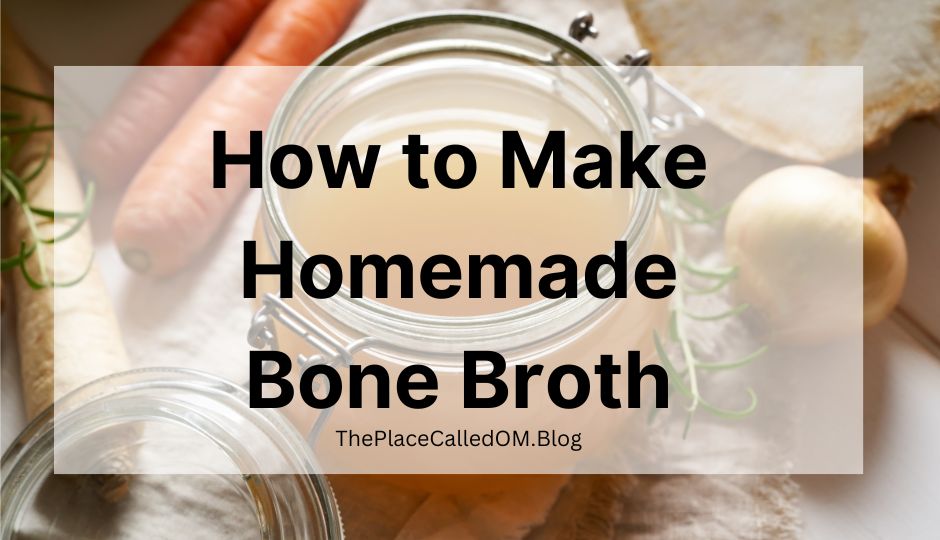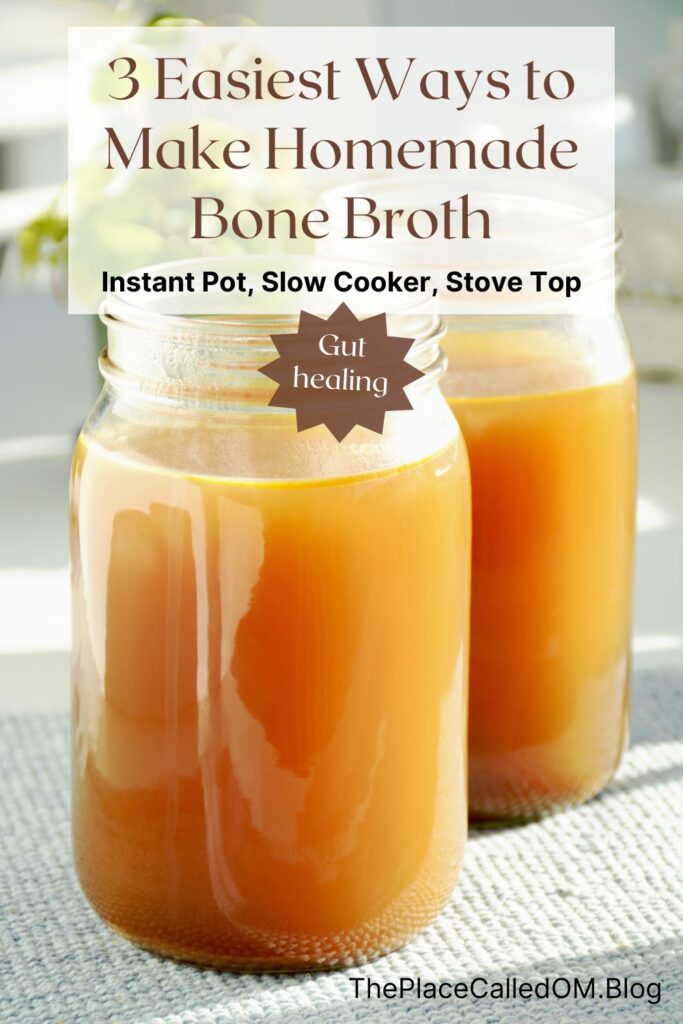Are you looking for the easiest way to make homemade bone broth? Look no further! I will share with you my favorite methods of making homemade bone broth the easy way. For years, I was intimidated by making bone broth at home and would spend so much money on pre-made bone broth at the grocery store. Unfortunately, cheaper bone broth has additives like artificial colors and ingredients, and expensive bone broth is, well, expensive. Seriously, you will save so much money by making homemade broth. I will also share all of the amazing health benefits of bone broth according to Western and Eastern medicine.

The Health Benefits of Bone Broth
Making bone broth is the process of extracting vital amino acids (proteins), minerals, and vitamins from animal bones and connective tissue. We do this by simmering the animal bones and meat in water for 12-24 hours. Consuming bone broth is one of the best ways to heal the intestines, lower inflammation, hydrate, and promote good immune health.
More bone broth benefits:
- Supports digestive disorders by promoting glutathione production and adequate hydrochloric acid
- Supports the liver in natural detoxification
- Contains Glycine (amino acid) needed for healthy fetus and infant development
- Promotes strong cartilage, bones, and joints
- Promotes glowing skin and strong nails and hair
- Reduces inflammation, which can boost the immune system and decrease allergies, arthritis, and asthma
- Can assist with boosting your metabolism to regulate weight
Bone broth has been used for centuries for its medicinal benefits. I recommend consuming bone broth daily (at least 8 ounces) to reap all the health benefits of bone broth. Feel free to get creative by adding bone broth to soups, stews, roasts, gravy, rice, pasta, and even hot chocolate! Make sure to spice it up with herbs and good salt such as Celtic or Redmond’s Real salt. Enjoy adding bone broth to many meals and recipes or sipping from your favorite coffee mug.
Traditional Chinese Medicine (TCM) and Bone Broth
In TCM, bone broth is used medicinally to heal and nourish the body. This is especially important for mothers after childbirth, those with chronic illness, malnourishment, trauma with blood loss, and digestive problems. The TCM Kidneys benefit from bone broth since they supplement the blood, bones, skin, and hair. If you work with a Chinese Medicine practitioner and have been diagnosed with a deficiency, bone broth is a nourishing option to heal conditions such as blood, qi, or yin deficiency. We recommend bone broth regularly in our clinic, and our patients always feel the difference. “Let food be thy medicine.”
Traditional Chinese Medicine Principles
Temperature: Warm
Flavor: Sweet, acrid
Actions: Nourish blood, build jing essence
Organs: Kidney, Liver, Spleen
Use if you are a postpartum or menstruating woman, those that have experienced blood loss, weak bones, hair, skin, or nails, foggy brain, dizziness, weak immune system, aid digestion, and overall wellness.
Common Questions about Bone Broth
Is there a difference between chicken bone broth and beef bone broth?
While both have their benefits, some would argue beef bone broth has a stronger amino acid (protein) content, which adds extra nutrients. I think both have great medicinal benefits! Go with whatever is available and affordable for you and your family.
Can I add fresh herbs and spices to my bone broth?
Yes! Absolutely. Feel free to get creative with additional flavors, such as fresh or dried herbs and vegetables. I love adding savory herbs such as thyme, rosemary, and sage to my broth.
What if I don’t have enough bones?
If you have less than 3 lbs of bones, that’s okay. You can still make broth with fewer bones, but I wouldn’t use less than one whole chicken carcass or three to four beef marrow bones. Use enough water to cover the bones when cooking, and you will still get a great bone broth!
You can always store leftover bones in the freezer until you have more bones to combine together for bone broth.
Can you cook the bones more than one time?
Yes, I like to cook the bones in 2-3 times (straining off the broth and adding more water each time) or until the chicken bones become soft and brittle.
What are the best bones to use?
Honestly, any animal’s bones will do. I personally recommend looking for quality, organic bones from grass-fed or pasture-raised animals. The health of the animal is important when consuming quality bone broth.
What is the difference between beef stock and beef bone broth?
Beef stock is typically made with meat and some bones (or sometimes no bones). I like to add meat and bones to my bone broth because it adds more flavor and nutrition.
I’m on a budget, how I can I make bone broth for cheap?
The best way to make bone broth affordably is to buy a whole chicken and use the bones to make your own bone broth.
What should I do with the layer of fat at the top of the bone broth?
If you are making beef bone broth, it is common to have a thicker layer of fat. You can put the broth in the fridge to let the fat harden and then remove from the broth. If the broth is still warm, you can use a fat seperator. Save the fat for cooking or discard it. I encourage you to keep the fat and cook with it either in a soup for frying in a pan. The beef fat is considered tallow, and the chicken fat is schmaltz. Both are nutritious and great sources of vitamins and healthy fat.
Do I have to roast the beef bones before making bone broth?
Nope. Roasting beef bones adds a depth of flavor that many people enjoy, but it’s not necessary—it’s optional! See below for instructions on how to roast beef bones.

The Easiest Bone Broth Recipe Methods
Buying premade bone broth from the store can get expensive. Plus, many brands include additives, preservatives, and coloring, even if they say organic. You can make your own for the same price or less at home! Here are a few tricks I’ve learned:
- Cut down on the cost of bones by buying a whole organic chicken and saving the bones to make broth. I usually save a few chicken carcasses to have enough bones for broth. If you can find chicken feet and necks at your local grocery store or butcher, add those for an extra collagen boost! My local grocery stores do not always have feet and necks available but they did have a turkey neck, which works too! I usually make 2-3 batches of broth from the same set of beef bones, so you get about a gallon of broth from one batch of bones (about 3 pounds of bones is ideal).
- You can purchase organic, grass-fed beef bones in the freezer section at most stores or contact your local butcher. I have also ordered grass-fed bones online through US Wellness Meats or Wild Pastures, which is great because they get shipped straight to my house!
Equipment you will need (depending on the chosen method):
- Instant Pot (Pressure cooker)
- Electric Roasting pan
- Slow cooker/ Crock pot
- Large stock pot
- Fine mesh strainer
- Backing sheet
- Mason jars or glass jars (storage)
- Ice cube trays
- Pressure canner (if needed)
Ingredients
- 3 pounds choice of meat bones- chicken bones (including necks and feet), beef marrow bones, game bones, or any mix (sometimes I combine chicken and beef bones)
- 8-12 cups filtered water (depending on how big your pot is)
- 1 yellow onion, quartered
- 2 organic Carrots, cut in large pieces
- 2 Stalks organic Celery with leaves, cut in large pieces
- 1 tablespoon salt
- 1 Tablespoon peppercorns or 1 teaspoon ground black pepper
- 4 cloves garlic, smashed
- 1 Tbs apple cider vinegar
- 2 Bay leaves (optional)
To roast or not to roast?
An optional step for beef bones is roasting them in the oven before adding them to your pot. Roasting bones before cooking in water helps add a delicious depth of flavor. It is an additional step but worth the effort! If you are in a hurry, though, you don’t need to roast the bones to achieve a nutritious bone broth.
Instructions for roasting bones:
1. Preheat oven to 425 degrees.
2. Place beef (or any animal bones) on a baking sheet.
3. Place baking sheet in the oven for about 15-30 minutes. The bones should be a golden brown color when done.
4. Remove the baking sheet from the oven and then add the roasted bones to your pot to start making bone broth.
Stove Top Preparation (the long way)
Making bone broth on the stove can be great. It just takes a long time and you must be home (for safety purposes) and have your stove on for 24 hours. Some enjoy this method because they keep a “perpetual bone broth” pot going for days. They strain off bone broth daily as needed and add more water for the next day. If this is convenient for you, GREAT! If this sounds impossible, see more options below. I don’t have time to babysit a pot of bone broth all day and night because we are busy and work full-time. This might be an excellent option for you! If not, see more options below 🙂
- Add bones to a large pot and enough room temperature water to cover the bones.
- Turn on stove to high heat and boil for 3-5 minutes. Foam and other impurities will bubble to the surface.
- Strain bones and discard water. Rinse bones and clean pot before returning bones to pot.
- Add all ingredients, including bones, to the large stock pot.
- Bring to a boil, then reduce heat to a simmer for 24 hours.
- Pour broth through a large fine-mesh sieve into a large bowl.
- Place broth in fridge to cool. The fat will separate and solidify, making it easier to skim.
- Skim off and save excess fat for cooking. You can leave the fat and use it in soups or other recipes.
Slow Cooker/ Electric Roaster Preparation (set it and forget it)
One of my favorite methods of preparing bone broth is in a slow cooker. You place all the ingredients in your slow cooker, set the temperature and time, and then walk away. You can do this in the morning before you leave for work or before you go to bed at night. I typically set my slow cooker on low for 10 hours and then select another 10 hours to get close to 24 hours. This method yields a beautiful bone broth!
- Add bones and enough water to cover in a large stockpot.
- Bring to a boil and boil for 3-5 minutes. Foam and other impurities will bubble to the surface.
- Strain bones and discard water. Rinse bones before adding to slow cooker.
- Add all ingredients to a slower cooker.
- Cook on low for 12-24 hours.
- Pour broth through a large fine-mesh sieve into a large bowl.
- Place broth in fridge to cool. This fat will separate and solidify, making it easier to skim.
- Skim off and save excess fat to use for cooking.
Instant Pot Preparation (quick and easy)
Need bone broth fast? Use an instant pot and have it finished in about an hour.
- Add bones and enough water to cover in a large stock pot.
- Bring to a boil and boil for 3-5 minutes. Foam and other impurities will bubble to the surface.
- Strain bones and discard water. Rinse bones before adding to InstaPot.
- Add all ingredients to the Instant Pot. Only fill the pot to MAX fill line.
- Close the vent and set it to Manual for 1 hour.
- Let the pressure come down naturally; do not release the vent. (unless you are in a hurry, then do a manual release of pressure)
- Pour broth through a large fine-mesh sieve into a large bowl.
- Place broth in fridge to cool. This fat will separate and solidify, making it easier to skim.
- Skim off and save excess fat to use for cooking.
Storage Options
- Fridge- store in the refrigerator for 4-5 days. Reheat to boil on the stove top.
- Freeze- pour broth into silicon molds and freeze for easy use.
- Preserve broth with pressure canning.https://www.youtube.com/watch?v=2bJT1zx-y4c
Use your homemade bone broth in these delicious recipes!
Simple Wellness Soup | Medicinal Recipe for Cold and Flu Symptoms
The Best Beef and Cabbage Soup- Gluten-free, Paleo
Dairy Free Wild Rice, Shiitake Mushroom, and Kale Soup Recipe for the Instant Pot

